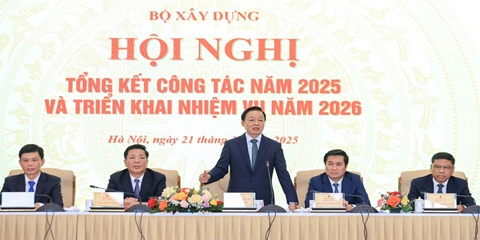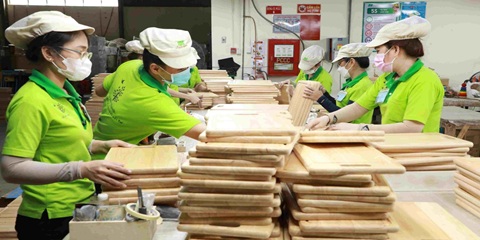Want to be in the loop?
subscribe to
our notification
Business News
COOPERATION IN BUILDING SUPPLY CHAINS IN GARMENT AND TEXTILE INDUSTRY
Considerable pressure
The Ministry of Industry and Trade forecast that after the Trans-Pacific Partnership (TPP) comes into effect, Vietnam’s exports to the United States are projected to be strongly affected and believed to reach US$51.4 billion. Garments and textiles alone may make up US$15.2 billion in 2020 and US$20 billion in 2025.
Mr Le Tien Truong, General Director of the Vietnam National Textile and Garment Group (Vinatex), said that the garment and textile industry is now employing 2.5 million workers and generating a fifth of jobs in the country every year. Vietnam is the fourth largest garment exporter in the world behind China, India and Bangladesh. The country has supplied over 4 per cent of total apparels on the planet. Labour productivity in the Vietnamese garment and textile industry is among the highest on the globe.
However, the industry is still relying on imported inputs. In 2015, exports brought in US$27.3 billion but input imports took US$13.5 billion. Domestic inputs valued US$13.8 billion, of which US$6 billion was spent on labour costs and US$7.8 billion was used for input materials, equal to 58 per cent of imported materials. High-value stages such as design, distribution, branding and package production, including original design manufacturer (ODM) are still very weak. Connectivity, market sharing, common customer service and cost optimisation in production are limited. Meanwhile, 90 per cent of 6,000 garment and textile companies in the country are small-scaled, with fewer than 500 workers. This scale is not effective and competitive in export. Therefore, they need to join hands to enhance effectiveness and strengthen competitiveness, said Le Tien Truong.
Mr Vo Tri Thanh, an economist, said that the localisation ratio in this industry is still very low. For example, apparel export earnings are among the top in the world but the sector is still heavily reliant on imported inputs.
The sector is weak in raw material production while the TPP provides that, to be levied zero tax, products exported must be sourced in TPP countries, originated from fibre (TPP) and from cloth (EU - Vietnam FTA). Imported materials must be from TPP member countries (TPP) or from EU and South Korea (EVFTA). Nevertheless, garment and textile materials being used in Vietnam are imported from China, Taiwan and Hong Kong, which are not TPP members.
Forming supply chains
Currently, domestic supplies garment and textile companies are accelerating the formation of supply chains based on the market principle of from yarn or fabric to sewing. Domestic suppliers can now meet approximately 40 per cent of fabric demand. If ongoing projects are put into operation before 2018, they will serve over 55 per cent of the demand. Other materials meet over 70 per cent. By 2020, the localisation rate may exceed 60 per cent.
Mr Hoang Ve Dung, Deputy General Director of Vinatex, said, to develop supply chains, Vinatex has strongly stepped from outsourcing to FOB and ODM. In 2015, Vinatex carried out 38 projects, including nine yarn projects, 10 textile projects, 14 garment projects and five other projects such as infrastructure and education with a total investment of more than VND6 trillion. Some projects have been completed, including Phu Hung spinning mill; garment factories in Kien Giang, Can Tho, Quang Binh, Bac Lieu and Tuyen Quang; Phu Cuong textile factory in Nam Dinh province and specially Que Son garment textile complex in Quang Nam province.
Recently, Vinatex launched its Vinatex Northern Corporation (VNC Corp) constituted by Hanoi Garment Textile Corporation, Garment Textile Company 8/3, Vinatex Knitting Company and Dong Xuan Knitting Company, and established Vinatex Southern Garment Textile Corporation with core companies being Dong Phuong, Phu Cuong, Kien Giang, Bac Lieu and Can Tho garment and textile companies. These supply chains will meet the rule of origin - yarn forward - in TPP and - fabric forward in EVFTA, said Mr Dung.
Vinatex members also created their own supply chains. For example, Viet Tien, Nha Be, Vietnam Thang, Duc Giang and Garment 10 garment corporations have ODM rate of 10 per cent, and FOB rate of 70 - 90 per cent. They are big enough to develop their own supply chains and cooperate with each other as well as with Vinatex Northern Garment Corporation and Vinatex Southern Garment Corporation to bring the ODM rate to 20 per cent in 2020.
In 2015, garment and textile universities and colleges enrolled more than 6,000 students and planned to enrol 2,900 more students in 2016, including 200 managers.
Source: VCCI
Related News

A STELLAR CHRISTMAS AT SOFITEL SAIGON PLAZA
Experience the magic of year-end celebrations in five-star luxury, where Parisian elegance meets Saigon’s festive vibrancy. Discover your Stellar Christmas moments: https://sofitel-saigon-plaza.com/festive-offer-2025

CONSTRUCTION SECTOR POSTS OVER 9% GROWTH IN 2025
Industries under the ministry’s management accounted for an estimated 17.23% of national gross domestic product (GDP), up about 0.17 percentage point from 2024. They contributed around 1.96 percentage points to overall GDP growth, reported the Vietnam News Agency. The contribution helped push Vietnam’s economic growth to above 8% in 2025 and supports the Government’s aim of pursuing double-digit growth in the coming years.

VIETNAM PUTS PUBLIC INVESTMENT DISBURSEMENTS AT VND603.6 TRILLION
Vietnam’s public investment disbursements had amounted to VND603.6 trillion in the year to December 18, equivalent to 66.1% of the plan assigned by the prime minister. According to the Ministry of Finance, actual disbursements by December 11 had totaled VND577.7 trillion, or 63.3% of the prime minister-approved plan of VND913.2 trillion, the Vietnam News Agency reported.

SHINE INTO 2026 AT HOIANA RESORT & GOLF!
This New Year’s Eve, celebrate where the sea meets the sky. Vibrant performances, festive dining, DJ beats, live bands and dazzling fireworks come together for one unforgettable night. From beachfront countdown moments to curated New Year’s Eve dinners across Hoiana, every detail is designed to welcome 2026 in style.

VIETNAM’S TRADE SET TO SURPASS US$900 BILLION FOR FIRST TIME
Vietnam’s total import-export turnover is expected to reach about US$920 billion by the end of the year, marking the first time the country’s trade value has exceeded the US$900-billion mark. As of December 15, Vietnam’s total trade turnover stood at US$883.7 billion, according to the Agency of Foreign Trade under the Ministry of Industry and Trade.

GLOBAL SOURCING FAIR VIETNAM 2026 – THE TRULY GLOBAL B2B SOURCING SHOW IN VIETNAM TO EXPAND & DIVERSIFY YOUR EXPORT MARKETS WORLDWIDE
The 4th edition of Global Sourcing Fair Vietnam returns in 2026 with an impressive scale, featuring 700 booths showcasing Fashion & Accessories, Home & Gifts, and the newly introduced Printing & Packaging Products from 500+ verified suppliers across Vietnam and Asia – including Mainland China, Taiwan, Hong Kong SAR, South Korea, India, Bangladesh, ASEAN, and more.
























